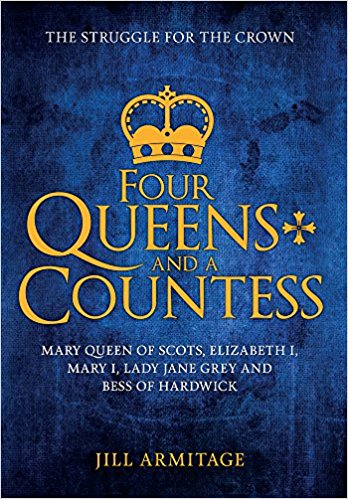 For all that we view the sixteenth century as a time of strict patriarchy and female subjugation, Tudor England saw some of the most dynamic, resilient and powerful women in history rise to prominence. In Jill Armitage’s ‘Four Queens and a Countess’, she explores the intertwined lives of Mary, Queen of Scots, Elizabeth I, Mary I, Lady Jane Grey, and the woman who knew them all: Bess of Hardwick.
For all that we view the sixteenth century as a time of strict patriarchy and female subjugation, Tudor England saw some of the most dynamic, resilient and powerful women in history rise to prominence. In Jill Armitage’s ‘Four Queens and a Countess’, she explores the intertwined lives of Mary, Queen of Scots, Elizabeth I, Mary I, Lady Jane Grey, and the woman who knew them all: Bess of Hardwick.
None of these queens were intended to rule, or desired as monarchs, at birth, and Bess’s origins similarly gave no hint of the woman she would become: Armitage observes that she was born into “relative obscurity”, and yet “Even in her lifetime, Bess of Hardwick was considered by many to be the stuff of legend – charismatic, forceful, determined, yet romantic.” Through four marriages of increasing prestige and a canny eye for account-keeping, Bess rose to become indispensable to the queens of England. She was companion to Jane Grey, Mary Tudor stood godmother to one of her sons, while Elizabeth entrusted Bess and her fourth husband, the Earl of Shrewsbury with the task of guarding Mary Stuart. Her story is a complex, and long-enduring one, and Armitage cuts through the tangled sixteenth century politics to create an incisive, clear narrative.
This book is particularly strong on establishing the shifting zeitgeist across the eighty-one years of Bess’s lifetime: as Armitage writes, “this was a patriarchal age, and no one believed that a woman could rule in her own right. Kingship was a man’s role.” As it became increasingly clear that there were no male Tudor heirs left, this gave way to a grudging acceptance that “a woman ruler was a necessary evil that had to be endured from time to time.” By the end of Mary’s reign, Armitage argues that, for all her failures, “she deserves more than our pity; she deserves our respect. Against all the odds, she had claimed her throne, married the man of her choice and turned the religious wheel round by making England a Catholic country again. She was a woman in a man’s world. She had proved that a woman could be queen and rule a country, and as such had set a template for Elizabeth to follow.”
As Elizabeth took the throne, the influence of female figures increased. The true powerhouses of the Elizabethan age were women: the queen herself, her rival across the border, as well as women like Margaret Douglas, Countess of Lennox, and the indomitable Bess. Armitage depicts their schemes and conspiracies with clarity, wearing her research lightly as she explores how Margaret and Bess engineered the birth of Arbella Stuart, their mutual granddaughter and candidate for the succession, as well as the plots of Mary, Queen of Scots, and how these ultimately contributed to the disintegration of the Shrewsbury marriage.
Depicting the lives of five hugely significant Tudor women would be an immensely ambitious scope for any book, and with ‘Four Queens and a Countess’ weighing in at just 220 pages, it sometimes leads to a lack of depth surrounding key events – Jane Grey’s execution, for instance, is dealt with in two sentences, which seems a bit dismissive for a title character. However, as an overview of the age and the relationships between these women, Armitage’s book is certainly successful: it’s an engaging and knowledgeable read, and I’d highly recommend it for anyone looking for an introduction to Bess of Hardwick and the times she lived through.















this sounds so intetesting. I love books that show strong female power. Especially in history!
Cannot wait to get my hands on this book!!
Sounds like a bit more of the same, but not really in-dept. I stick with the biographies of the seperate Queens & Countess. Thanks for the review.
My American best friend has written a fictional book based on the facts of history now published called the “Nymph from Heaven” it’s by Bonny G Smith and follows the life of Henry’s sister Mary Tudor, from her marriage to a French king to her love for Charles Brandon and the rise of Anne Boleyn. I am biased but it’s one of the best fictional Tudor books I’ve read and would love you all to read it. It’s for sale at Amazon.